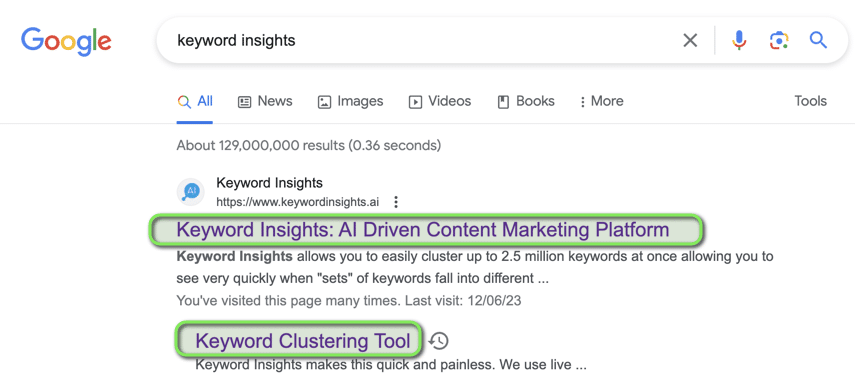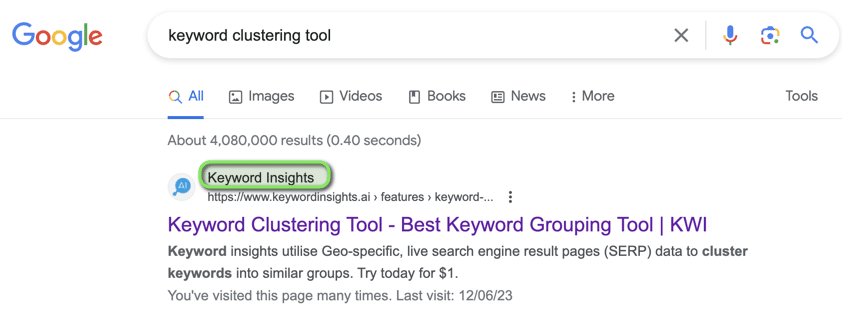Home / Blog / Fundamentals / Meta Titles – What are meta titles, how to optimise them and 4 examples
Meta Titles – What are meta titles, how to optimise them and 4 examples

Jun 13, 2023
Share to
Have you ever wondered about those bold headlines you click on Google when searching for something? Those are meta titles, serving as the name of a webpage. It’s like a book’s title but for a webpage, telling both search engines and users what your page is about.

Let’s set the record straight here: using the term “meta titles” isn’t entirely accurate. Why? Because they aren’t genuinely part of the “meta element” in HTML code. If you take a closer look at the code below, you’ll see the <title>, “AI-Driven Content Marketing Platform | Keyword Insights” </title>, stands alone and is not enveloped by the “meta element”. Just a little technical tidbit to keep our SEO chatter as precise as possible.

However, in this article, I’m aligning myself with the popular term “meta title”, solely because that’s what the majority are searching for. Yes, you caught me, I’m playing to the gallery here. Even SEO writers have to make sacrifices sometimes, all in the name of higher search volume. A touch of irony, isn’t it?
Let’s dive in.
Understanding the Basics of Meta Titles
The Role of Meta Titles in SEO
As the proverbial name tags of your web pages, meta titles are primarily how search engines determine the relevancy of your content to a user’s search query. They’re the initial handshake between your website and a search engine’s algorithm, which makes them an absolute powerhouse in your SEO strategy.
What makes a good meta title? Keywords. Specifically, relevant keywords that align with your content and the terms your target audience is searching for. If your meta title accurately represents your content and includes the right keywords, search engines will be more likely to match your page with a user’s search query.
The Relationship Between Meta Titles and SERP Rankings
Let’s talk about SERP rankings. We’ve all dreamt of reaching the elusive first page of Google, and your meta title is one ticket to that VIP section.
Google and other search engines prioritize webpages they believe are most relevant to a user’s search. If your meta title effectively conveys the content of your page and matches a search query, you increase your chances of securing a top spot. In a nutshell, a well-crafted meta title tells search engines: “Hey, this page is exactly what the user is looking for!”
Character Limits and Optimal Length for Meta Titles
When it comes to meta titles, size does matter, but perhaps not in the way you might think. The common guideline is to keep your meta titles within 50-60 characters as that’s the limit displayed by most search engines. Yet, it’s important to remember that Google actually uses pixel width, not character count, to determine what to display. The recommended pixel width is around 580 pixels (but it’s obviously harder to use this if you’re working in Excel spreadsheets or something so character count is easier).
It’s essential to note there isn’t actually any hard evidence suggesting titles exceeding this limit will take a hit on your SEO. That said, the user experience remains a vital consideration. Titles that are too long might get cut off in the SERP, potentially leading to confusion or a lack of interest from users. This could impact your click-through rates, and there is evidence to suggest that click-through rates can have an indirect effect on your rankings (being deliberate with my choice of language there).

The goal is to craft a meta title that succinctly conveys your content’s purpose, incorporates relevant keywords, and entices users—all ideally within that 50-60 character sweet spot (or 580 pixels to be more accurate). So, it’s less about fearing the character count and more about making every character count. Don’t make it too short and don’t make it too short.
How Meta Titles Influence Click-Through Rates
For human users, your meta title is the neon sign that catches their eye. A well-crafted one can increase the chances of users clicking on your link, improving your click-through rates (CTR).
How to Write Effective Meta Titles
Importance of Keyword Placement
The secret sauce in an effective meta title? Keywords, of course! But it’s not just about including them—it’s about where you place them. As a rule of thumb, try to position your primary keyword towards the beginning of your title. Why? Because search engines tend to give more weight to the initial words in the title tag. Plus, users scanning results will typically notice those first few words more. For example, if “vegan cake recipe” is your primary keyword, start your title with “Vegan Cake Recipe: Delicious and Easy to Make” rather than “Easy and Delicious Recipe for a Vegan Cake”.
Using Brand Names in Meta Titles
If you’ve been wrestling with the idea of incorporating your brand name into your meta title, here’s a comforting thought. It used to be common wisdom to include your brand name in the meta title, typically placed at the end, to add credibility and recognition to your page.
However, Google has adapted its display to automatically show the brand name at the top of the search listing, freeing up some precious space in your meta title. So you don’t have to play word Tetris to fit your brand name anymore when dealing with Google.

But remember, this display feature isn’t universally adopted by all search engines. So, if you’re targeting multiple search engines, you might want to consider still incorporating your brand name. Otherwise, you can fully utilize the title space for your primary keywords and compelling descriptors.
The Art of Creating Descriptive yet Concise Titles
Crafting an effective meta title is akin to writing a mini-masterpiece. It’s about being clear and descriptive while also being concise. The aim is to tell users and search engines what your webpage is about in as few words as possible while making it enticing enough to invite that all-important click. For example, “10-Minute Yoga Routine: Boost Energy and Reduce Stress” tells users exactly what to expect and why they should click.
Avoiding Duplicate Titles
Just as every snowflake is unique, so should every meta title on your website. Duplicate titles can confuse search engines and could potentially dilute the ranking strength of your pages. Always aim for unique meta titles that accurately reflect each page’s content.
The Balance Between SEO and User Friendliness
Finally, remember that your meta title serves two masters: search engines and users. It needs to be SEO-friendly to rank high, but it also needs to be user-friendly to attract clicks. Striking this balance can be challenging, but the payoff is worth it. Consider readability, relevance, and curiosity when crafting your title. You want search engines to understand it, but ultimately, you want users to click on it. For example, “New to Hiking? A Beginner’s Guide to Trails and Gear” balances SEO considerations (keywords like “hiking”, and “beginner’s guide”) with a user-friendly format that speaks directly to the reader.
There you have it—the key elements of crafting effective meta titles. It’s part science, part art, and wholly crucial for your web page’s success.
We’ll now cover some more advanced techniques to optimise your titles.
How to Optimize Meta Titles
Use Primary Keywords Strategically
Optimization begins with the strategic use of your primary keywords. These are the core terms that define your webpage’s content and should be used towards the beginning of your meta title to grab attention from both users and search engines. For instance, if you’re writing about “organic coffee beans”, your meta title might start with “Organic Coffee Beans: …”
Incorporate Secondary Keywords
While your primary keyword takes centre stage, don’t forget about your secondary keywords. These are related terms that can help diversify your keyword strategy and further enhance your relevancy. But remember, your title still needs to sound natural—don’t force in keywords where they don’t fit. For example, if your primary keyword is “vegan skincare”, secondary keywords could be “cruelty-free” or “plant-based”. Your title could read “Vegan Skincare: The Best Cruelty-Free and Plant-Based Products”.
Capitalise on Geo-targeting (If applicable)
For businesses with a local focus, geo-targeting can be a game changer. By incorporating your location into your meta title, you can rank higher in local search results and attract users in your area. Just ensure it makes sense for your business and audience. For example, if you run a yoga studio in Melbourne, your title could be “Melbourne Yoga Studio: Top-Rated Classes”.
Add Modifiers
By adding modifiers—like “best”, “review”, “guide”, or the current year—you can target specific, less competitive searches, benefiting from long-tail SEO. For example, “2023 Guide to Best DSLR Cameras for Beginners”.
Incorporate Unique Selling Propositions (USPs)
Your USPs make you stand out from the competition, and including them in your meta title can persuade users to choose your page. For example, if your USP is free next-day delivery for an online clothing store, your title could read “Trendy Clothing with Free Next-Day Delivery”.
Adding Numbers to Boost Attractiveness
Titles with numbers, especially odd ones, can stand out and attract more clicks, according to numerous studies. It seems the specificity of a number piques curiosity. For example, “Tips for Plant-Based Diets” could transform into “7 Essential Tips for Thriving on a Plant-Based Diet”. This gives your title a clear, engaging angle.
Use Title Case
Using Title Case in your meta titles is another smart move. Not only does it help your title pop on the SERPs—lending it a more polished, professional look—but it can also drive those click-through rates up. Plus, title case ramps up readability by setting each word apart, a real bonus when users are scanning for information at speed.
Remember, the faster they can grasp your title, the quicker they’ll be likely to click on it.
Testing and Refining Meta Titles
The optimisation process is ongoing. Test different versions of your meta titles to determine what works best. For instance, if your original title was “Expert Plumbing Services | YourTown Plumbers”, you might test a variant like “YourTown Plumbers: 24/7 Expert Plumbing Services”. Monitor metrics like click-through rates and rankings to inform your refinements.
These examples should give you a clearer idea of how each of these optimization techniques can be applied to your meta titles. A great tool to test these easily is SEO Testing.
Common Mistakes to Avoid When Crafting Meta Titles
Keyword Stuffing
One pitfall that’s easy to stumble into is keyword stuffing. This is when you cram as many keywords as possible into your title, with the belief that more equals better. But this tactic can backfire. Not only can it result in a title that’s hard to read and understand, but search engines might penalize your page for this practice. It’s always better to use your chosen keyword naturally. For example, instead of “Buy vegan shoes, vegan boots, vegan sandals, vegan trainers”, a better title would be “Shop Quality Vegan Shoes: Boots, Sandals, and Trainers”. Although this is probably a poor example as it’s likely all those keywords should be targeted on separate pages anyway; something our SERP similarity tool or clustering tool would tell you.
Creating Generic Titles
Generic titles are another common error. If your title is too vague or broad, it may fail to attract users’ attention or rank for specific keywords. To avoid this, try to make your titles as specific and unique as possible. For instance, instead of “Healthy Recipes”, consider a title like “Quick and Healthy Dinner Recipes for Busy Weeknights”.
Neglecting the Importance of CTR
Lastly, don’t forget about click-through rates (CTR). Some may focus too much on ranking and forget that the end goal is to get users to actually click on their page. Your title should be compelling and enticing to users, not just optimized for search engines. Consider what would make a user want to click on your link. For example, does your title solve a problem? Does it promise valuable information? Does it pique curiosity? Remember to keep the user’s perspective in mind when crafting your title.
Tools and Resources for Creating and Testing Meta Titles
Introduction to Popular Meta Title Tools
Several online tools can assist you in creating effective and optimized titles. If your site is on WordPress, tools like Rankmath or Yoast provide real-time feedback on your title’s SEO strength, flagging up issues like length, keyword placement, and readability. Simply put, they offer a user-friendly way to craft effective, SEO-optimised meta titles without needing advanced technical knowledge.
Tools like this, and this offer features that allow you to preview how your title will appear in search results, and check character/pixel count if you’re spot-checking how they may look.
If you’re using our Content Brief Generator to write your content, we’ll actually analyse the SERP results and use AI to help you write a meta title really quickly.
I’ve also mentioned this one earlier, but SEO Testing lets easily test different meta titles (amongst other things) to see which works best for you.
Utilizing Search Console and Analytics Data for Improvement
Beyond these dedicated tools, don’t forget about the wealth of data available from Google Search Console and Google Analytics. Search Console can show you how your webpages are performing in terms of impressions, clicks, and click-through rates. If a page isn’t getting many clicks, it could be worth experimenting with a new meta title.
Google Analytics can provide further insights. Look at your top-performing pages in terms of organic traffic. What do their meta titles have in common? Can you apply those elements to other pages? By combining data analysis with the use of meta-title tools, you can continually refine your titles for maximum effectiveness.
These tools and resources can help take the guesswork out of creating and testing meta titles, making your SEO efforts more precise and effective.
Real-World Examples of Effective Meta Titles
Studying real-world examples from various industries can provide invaluable insights into what makes a meta title effective. Let’s break down why these specific examples work, taking into consideration their use of keywords, readability, length, and the overall message they convey to the potential visitor:
- eCommerce: “Men’s Running Shoes | Free Shipping | BrandX”. This title is effective because it incorporates the main keyword “Men’s Running Shoes” at the beginning, mentions a unique selling proposition “Free Shipping”, and includes the brand name at the end.
- Content Marketing: “7 Steps to Master SEO: The Beginner’s Guide | ContentSite”. Here, the number ‘7’ grabs attention, the primary keyword “SEO” is near the start, and the title tells users exactly what to expect.
- Local Business: “Award-Winning Italian Restaurant in London | BellaCucina”. This title starts with a unique selling proposition “Award-Winning”, uses geo-targeting “in London”, and ends with the brand name.
- Non-profit: “Join Us to Protect Endangered Wildlife | EarthCare”. This title starts with a call to action “Join Us”, then explains the page’s purpose, and ends with the brand name.
Of course, you don’t have to include the brand name at the end as we mentioned earlier, especially if you’re running short of character/pixel length.
Conclusion
Congratulations, you’ve now journeyed through the ins and outs of meta titles—an essential, yet often under-appreciated, component of effective SEO. As we’ve seen, crafting powerful meta titles is about far more than just ticking SEO boxes. It’s about clarity, conciseness, relevance, and striking a delicate balance between appeasing search engines and appealing to human curiosity.
We’ve explored the why, the what, and the how of meta titles: from the crucial role they play in SEO and SERP rankings, to the impact they have on click-through rates. We’ve unravelled the best practices for writing and optimising meta titles, learning to integrate keywords effectively, avoiding duplication, balancing SEO considerations with user-friendliness, and harnessing the power of numbers (ideally odd numbers) and unique selling propositions.
Armed with practical tools and real-world examples, you now possess a roadmap for creating meta titles that not only catch the eye of both search engines and users but compel those users to click and engage with your content. The ultimate goal? Boosting your search visibility, driving traffic, and ultimately, growing your brand’s online success.
Remember that the art of crafting the perfect meta title is a continuous process of learning, testing, refining, and learning again. It’s a dynamic challenge that requires a creative and analytical approach. Stay informed about evolving SEO trends and changes in search engine algorithms. Always be ready to tweak and adapt your titles accordingly. As search behaviours change, so should your strategies.
In closing, bear in mind this simple mantra: meta titles are your first point of connection with your potential audience in search results. Make that first impression count, make every character count. Your meta titles can be tiny powerhouses of SEO potential. It’s up to you to unlock it.
Good luck in your meta title crafting journey, and here’s to skyrocketing click-through rates and impressive search engine rankings! For more reading, we’d highly recommend reading our complete guide on how to structure a blog post.
Oh and remember, they’re actually called “page titles” – not “meta titles”.
Start your trial today for only $1
Sign up today for a $1 trial and enjoy access to 6000 keyword clustering credits, 3 Keyword discovery searches, 1 Content Brief and Pro versions of SERP Similarity, SERP Explorer.
Subscribe to our newsletter
Subscribe to get our latest news, offers, insights, and any updates.

